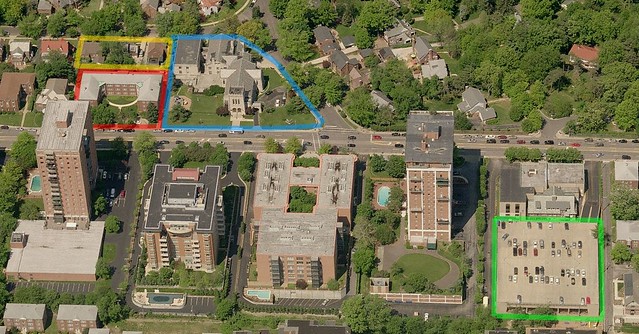
{church in blue – condo demolition in red – future home demolition in yellow – existing parking in green}
The final decision has been delayed, but the Post-Dispatch is reporting that the Central Presbyterian Church, Clayton Board of Aldermen and Davis Place subdivision trustees have reached an agreement to demolish the condo building at 825 Hanley Road, in the middle of one of the city's most dense residential neighborhoods. nextSTL covered this issue previously in December 2010 and suggested several alternatives to demolition. We understand it's all the rage these days, demolishing perfectly functional (and in this case occupied) buildings for "progress" (and in this case a surface parking lot), but the utter lack of expectations for our built environment is creating less livable communities.
The apparent resolution here means that the mantel of first municipality to commit to being a dense, walkable, sustainable place to live is still up for grabs. Kirkwood decided to pursue self-inflicted suburbanism and the quest to clear the City of St. Louis for park-like settings and suburban buildings continues nearly unabated. Not only will Clayton lose residents to a tax-exempt religious organization's parking lot, it's set to lose more. The agreement only delays the demolition of three homes immediately to the south of the church.
Once these homes and buildings are gone and replaced with surface parking, it will be decades before they are redeveloped, if ever. Better solutions are obvious. Existing structured parking exists 1/8 of a mile away. For the cost of demolition, construction and maintenance of a parking lot, and lost revenue to Clayton, many creative and effective solutions are possible.
The current situation has the church giving the ultimatum that either the adjacent neighborhood relax its parking restrictions, or they will demolish three homes (in addition to the condo building facing Hanley), paving a scar in the neighborhood and leaving several homes facing a blank blacktop. What happens if church activities increase? What if additional parking is needed? Then the homes will go, and then potentially additional homes. The current agreement, unfortunately, isn't a plan, it's a hostage situation.

{the Clayton Board of Aldermen are set to consider the above modified parking regulation plan}
The following previously appeared on nextSTL:
 The problem: sidewalks are too narrow and abut a high-speed arterial road without a tree lawn, crosswalks are faded and lack lighted signals, parking is 660 feet from the destination. The solution: demolish buildings and build more parking 200 feet from the destination.
The problem: sidewalks are too narrow and abut a high-speed arterial road without a tree lawn, crosswalks are faded and lack lighted signals, parking is 660 feet from the destination. The solution: demolish buildings and build more parking 200 feet from the destination.
At least this may be the preferred solution by the Central Presbyterian Church on Hanley Road in Clayton. The Post-Dispatch had a short mention online regarding the issue. The church owns 190 parking spaces at the Central Christian School across Hanley and approximately 660 feet from the church. A nearby resident reports being told by the church that they don't use that parking because church goers do not like to cross Hanley Road.

{current conditions at Hanley Road at Davis Drive}
The potential demolitions? A 16-unit apartment building adjacent to the church and three single-family homes facing the church across residential Davis Drive. It's a fact that fewer people walk to church today, parking is in demand. Many churches have left urban locales for suburban plots easily filled with asphalt to accommodate the one or twice weekly crowds. The Archdiocese of St. Louis recently bought, vacated, neglected and leveled the San Luis building in the city's most dense neighborhood, the Central West End, for parking.
{homes on Davis Drive potentially targeted for demolition}
The problem is that Hanley isn't pleasant to cross, or walk along. Why isn't the priority a quality pedestrian crossing for Hanley and sidewalks with a tree lawn? 660 ft., or 1/8 of a mile. This distance, as it is, is indeed too much for some. Crossing Hanley on a Sunday morning, or any other day with children, or for someone older than most is clearly no picnic.
Hanley resembles a highway more than a city street. Traffic is in invited to travel well above the speed limit and regularly rolls through at 40mph. And why not? There are four traffic lanes, an unobstructed center turn lane and no trees adjacent to the road. This is another example of a traffic pyramid scheme: widened, cleared, fast roads create an inhospitable pedestrian realm necessitating demolition of homes and other buildings for parking immediately next to ones destination, which creates an even more inhospitable pedestrian realm.
Better sidewalks and better pedestrian connections would benefit not just the church, but the neighborhood and visitors. Demolishing a 16-unit building and three single family homes, and then building parking would certainly cost millions, benefit only the church and be detrimental to neighbors and others. What kind of pedestrian crossing could be constructed with say $3 million?
For that amount a pedestrian bridge could be built, not that this is a good location for one. Heck, Lumiere Casino built a 400-foot tunnel with moving walkway under I-70 for approximately $8 million. The problem, as it is, presents an opportunity for a creative solution that could provide an example for region and best fulfill the church's stated mission to be a good neighbor. The following are just a few possibilities for a better solution than demolition and more parking.

{illustration of basic pedestrian crossing improvements}

{lighted crosswalks and crossing signs improve the pedestrian experience}

{a simple pedestrian refuge can greatly improve walkability}

{an overhead lighted crossing or other signage could better demonstrate a pedestrian presence to traffic}

{a light screen gives pedestrians a larger presence}


